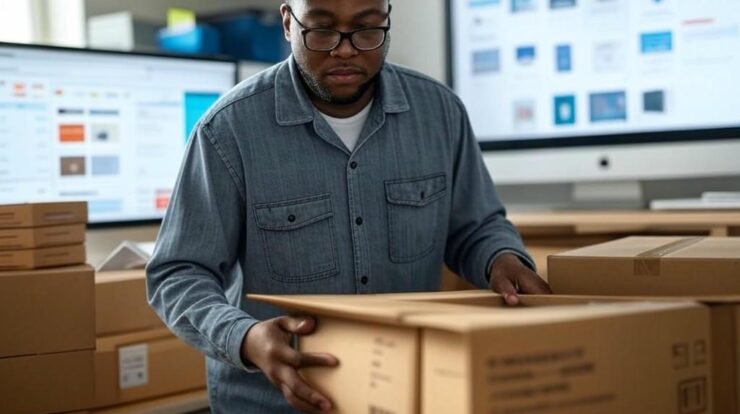In today’s gig economy, finding ways to make extra cash from the comfort of your home is more appealing than ever. One avenue that’s gained significant traction is getting paid to test products at home. It’s a flexible, engaging, and often enjoyable way to earn money while trying out new items before they hit the market. As someone who’s spent years exploring side hustles and diving deep into the world of product testing, I’m here to share everything you need to know about this opportunity—how it works, where to find legitimate gigs, and how to maximize your earnings while avoiding scams.
What Does It Mean to Get Paid to Test Products at Home?

Product testing, sometimes called consumer testing or user testing, involves companies sending you products to try out and provide feedback on. These could range from everyday household items like kitchen gadgets or beauty products to cutting-edge tech like smart home devices or fitness trackers. In exchange for your honest opinions, companies compensate you with cash, gift cards, or free products.
The concept is simple: businesses want real-world insights to refine their products before launching them to the masses. By testing products at home, you’re helping brands ensure their items meet consumer expectations. It’s a win-win—you get paid or receive free stuff, and companies get valuable feedback to improve their offerings.
Why Companies Pay for Product Testing
Before diving into how to get started, it’s worth understanding why companies are willing to pay for your input. Developing a new product is expensive, and launching a flop can cost millions. To avoid this, brands rely on consumer feedback to fine-tune their designs, packaging, or functionality. For example, a skincare company might want to know if their new moisturizer feels greasy or absorbs well, while a tech company might need insights on whether their app’s interface is user-friendly.
By participating, you’re essentially acting as a quality control agent. Your feedback helps companies avoid costly mistakes, making your role critical to their success. This is why reputable companies are happy to compensate you for your time and opinions.
Read more: AI Interactive Books Review: A Game-Changer for Content Creators
Who Can Get Paid to Test Products?
One of the best things about product testing is its accessibility. You don’t need a college degree, specialized skills, or years of experience. Most companies are looking for everyday consumers who represent their target audience. Whether you’re a stay-at-home parent, a college student, or someone looking to supplement their income, product testing can fit into your lifestyle.
That said, some opportunities may have specific requirements. For instance, a company testing a new gaming console might prefer participants who are avid gamers, while a baby product brand might target parents. But with the variety of products out there, there’s likely something for everyone.
How to Get Started with Product Testing
Ready to jump in? Here’s a step-by-step guide to help you start earning money by testing products from home.
1. Find Legitimate Product Testing Platforms
The first step is identifying trustworthy platforms that connect you with product testing opportunities. Not all websites offering “get paid to test products” gigs are legit, so it’s crucial to stick with reputable companies. Here are some well-known platforms to consider:
- UserTesting: Focused on digital products like apps and websites, UserTesting pays you to test user interfaces and share your experience. Payments typically range from $10 to $60 per test, depending on the complexity.
- Pinecone Research: This market research platform occasionally offers product testing opportunities alongside surveys. They pay via PayPal, gift cards, or checks, with most tasks earning $3 to $5.
- BzzAgent: BzzAgent sends free products in exchange for reviews and social media buzz. While they don’t always pay cash, you get to keep the products, which can range from snacks to cosmetics.
- Toluna: Toluna combines surveys with product testing, rewarding you with points redeemable for gift cards or cash. They often send out beauty and household products.
- TryIt Sampling Community: Run by Bazaarvoice, this platform connects you with brands looking for product testers. You’ll receive free products and may be asked to share reviews online.
Pro tip: Sign up for multiple platforms to increase your chances of getting selected. Each platform has its own process, so diversify your options to maximize opportunities.
2. Create a Strong Profile
When you sign up for these platforms, you’ll typically need to complete a profile with demographic information like your age, gender, location, and interests. Be honest and detailed—companies use this data to match you with relevant products. For example, if you’re a fitness enthusiast, mentioning your interest in workouts could land you a gig testing a new fitness tracker.
Some platforms may also ask for a short bio or photo. Take the time to craft a professional yet approachable profile. This small effort can make you stand out when companies are selecting testers.
3. Be Proactive and Responsive
Product testing opportunities often come with limited spots, so act fast when you receive an invitation. Check your email regularly and complete any screener surveys promptly. These short questionnaires help companies determine if you’re a good fit for the test.
Once selected, follow instructions carefully. Whether it’s using a product for a set period or answering specific questions, attention to detail is key. Providing thorough, thoughtful feedback increases your chances of being invited back for future tests.
4. Watch Out for Scams
Unfortunately, the promise of getting paid to test products attracts scammers. Red flags include companies asking for upfront fees, promising unrealistic earnings, or requesting sensitive personal information like your Social Security number. Legitimate product testing programs will never ask you to pay to participate.
To stay safe, stick with well-known platforms and research any company before signing up. A quick search for reviews or complaints can save you from falling into a scam.
Read more: Dream Site Pro Review: My Honest Take on This AI-Powered Website Builder
Types of Products You Can Test
The variety of products available for testing is vast, which is part of what makes this side hustle so exciting. Here are some common categories:
- Electronics: From headphones to smart home devices, tech companies often need feedback on usability and performance.
- Beauty and Personal Care: Skincare, makeup, and haircare brands frequently send out samples to gauge consumer reactions.
- Food and Beverages: Snack brands, beverage companies, and meal kit services may send products for taste tests.
- Household Goods: Think cleaning supplies, kitchen gadgets, or even pet products.
- Clothing and Accessories: Some programs offer apparel or accessories to test for comfort and style.
Each test is unique, and the compensation varies based on the product’s value and the time required. For instance, testing a $200 smartwatch might pay more than trying out a $10 shampoo.
How Much Can You Earn Testing Products?
Your earnings depend on the platform, the type of product, and the time commitment. Here’s a rough breakdown:
- Cash Payments: Platforms like UserTesting pay $10–$60 per test, with most tests taking 10–20 minutes. Pinecone Research typically pays $3–$5 per product test or survey.
- Free Products: Many programs, like BzzAgent and TryIt, let you keep the products you test, which can be worth $5–$100 or more.
- Gift Cards and Points: Platforms like Toluna reward you with points redeemable for gift cards or cash, often equating to $1–$15 per task.
While product testing won’t make you rich, it’s a solid way to earn extra cash or score free stuff. If you’re consistent and sign up for multiple platforms, you could realistically earn $50–$200 a month, depending on how many tests you complete.
Read more: AiProductEngine Review: My Honest Take on This Game-Changing Tool
Tips to Maximize Your Earnings

To make the most of product testing, consider these strategies:
- Join Multiple Platforms: Don’t rely on one site. Signing up for several increases your chances of getting regular tests.
- Be Consistent: Complete tests promptly and provide high-quality feedback. Companies often prioritize reliable testers for future opportunities.
- Leverage Social Media: Some programs, like BzzAgent, reward you for sharing your reviews on social media. Build a small following to boost your chances of getting selected.
- Track Your Earnings: Keep a spreadsheet of your tests, payments, and free products to stay organized and ensure you’re paid on time.
- Stay Engaged: Even if you’re not selected for a test, complete screener surveys and stay active on platforms to remain top-of-mind for future opportunities.
The Pros and Cons of Product Testing
Like any side hustle, product testing has its upsides and downsides. Here’s a quick overview:
Pros
- Flexibility: Test products on your own schedule, perfect for busy lifestyles.
- Low Barrier to Entry: No special skills or experience required.
- Fun and Engaging: Trying new products can be exciting, especially if you love discovering new brands.
- Extra Income: Earn cash or free products with minimal effort.
Cons
- Inconsistent Opportunities: Tests may not come regularly, so it’s not a reliable full-time income source.
- Time-Intensive Feedback: Some tests require detailed reviews or lengthy surveys.
- Scam Risks: You’ll need to stay vigilant to avoid fraudulent companies.
Building Trust as a Product Tester
To succeed long-term, focus on building a reputation as a reliable tester. Companies value testers who provide thoughtful, honest feedback. Here are a few ways to establish trust:
- Be Honest: If a product doesn’t meet expectations, say so constructively. Companies appreciate candid feedback.
- Meet Deadlines: Submit your reviews or surveys on time to show you’re dependable.
- Engage Fully: Follow instructions carefully and provide detailed responses to stand out.
Over time, your reliability can lead to more frequent invitations and even exclusive opportunities with higher payouts.
Combining Product Testing with Other Side Hustles
If you’re looking to boost your income further, product testing pairs well with other side gigs. For example:
- Online Surveys: Many product testing platforms, like Pinecone Research and Toluna, also offer paid surveys.
- Freelancing: Use your product testing experience to write reviews or create content for brands as a freelance writer.
- Social Media Influencing: Share your product testing experiences on Instagram or TikTok to build a following and attract sponsorships.
By diversifying your side hustles, you can create a more stable income stream while still enjoying the flexibility of working from home.
Final Thoughts on Getting Paid to Test Products
Getting paid to test products at home is a fantastic way to earn extra money or score free goodies while helping brands improve their offerings. It’s not a get-rich-quick scheme, but with the right approach—signing up for reputable platforms, staying proactive, and avoiding scams—you can make it a rewarding part of your financial journey.
The key is to start small, experiment with different platforms, and build a reputation as a reliable tester. Over time, you’ll find the opportunities that best fit your interests and lifestyle. So why not give it a shot? You might just discover a new favorite product while padding your wallet.
Happy testing!





